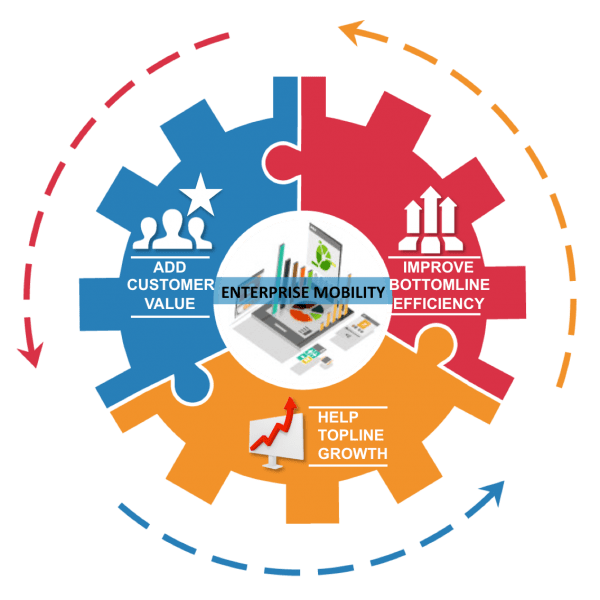Enterprise mobility: What would you spend to prove viability?

Enterprise mobility: What would you spend to prove viability?
November 26, 2015
Technology evolution in the mobility space is happening at an unprecedented pace. An enterprise embracing the mobile channel as a core mode of engagement for its customers, employees and partners will realize these benefits effectively.

Technology evolution in the mobility space is happening at an unprecedented pace. Enterprises by gain in productivity, top line and bottom line growth through enablement of day-to-day functions on mobile devices, Enterprises can gain productivity benefits, top line and bottom line growth; the potential is immense. An enterprise embracing the mobile channel as a core mode of engagement for its customers, employees and partners will realize these benefits effectively. While the above rhetoric has been prevalent for some time now, the market still lags mainstream adoption of enterprise mobility solutions. For example, the primary tools for most field workers remain the trusty clipboard, pen, phone and point-and-shoot camera. I find that odd; surely, with the technology at our disposal today, field workers should be using mobile devices that are fully integrated into business operations.

The answer isn’t simple – many reasons like business complexity, unclear ROI, business priority, inadequate IT, security, and training overheads hinder adoption of mobility solutions. This means that many businesses, despite being aware of the potential, continue to dabble with mobility initiatives without a clear strategy. Even more alarming is that businesses are investing more than ever before, but not realizing benefits as anticipated; leading to excessive caution in allocating additional spending to mobility initiatives.
In conversations with many businesses we find there is a desire to test waters before taking the big plunge. This is good. Businesses find it hard to quantify the value from enterprise mobility proposals, and often the budgetary estimations for enterprise mobility rollouts are intimidating. As a result; plans are shelved, de-scoped heavily or prioritized only for certain functions or tasks, and therein lies the problem.
A mobility initiative should never be only about giving an employee a tool or a digitized workflow to make them more productive.
Mobility should be about transforming an end-to-end business or operational process so that it adds customer value, improves bottom line efficiencies and helps top line growth.
The question we like to ask is “What would you be willing to spend per user to establish the viability of a mobility initiative?”
A case in point
When appointed with the task of assessing the cost for building a complex multi tiered mobile app to aid an automotive auction company, Popcornapps took the judicious decision to roll out a pilot that catered to a small but entire end-to-end business process so that the scale of the project and its impact on the entire business could be understood with minimal investment earlier on already a billion-dollar business and selling over 1 million units annually, they stock, assess and process inventory in 200 facilities; employing over 3000 field workers. PopcornApps developed a proof of concept solution for 50 field workers in 3 of the facilities. Field staff could perform ALL their tasks across the end-to end-process- from inventory intake, condition assessment, report submission, inventory valuation and approval to auction. The results in these ‘pilot’ yards were mind blowing;
- Average inventory processing times down from 1 week to 2 days
- Worker error rates down from 2.1% to 0.3%
- Administrative and coordination overheads down by over 50%
- A huge increase in the granularity of management visibility into every part of the field operations process
- An almost total elimination of paper (a lot of ballpoint pens made redundant)
The cost of deploying the solution across 200 facilities, including apps, server software, mobile devices, integration, network, and contracted support fees came to ₹144,595,000.00 across a 3 year period. That is ₹18,994.53 per field worker a year. In the same period the said client will realise a saving of ₹525,800,000.00 in existing and budgeted spend through savings in human effort, admin costs, and improved efficiencies.
The same client witnessed the rise of non-traditional browsers hitting its website – A dramatic rise in number of tablets and smartphones accessing a transactional website led to one conclusion – their customers wanted to transact over the mobile channel – that meant browse, select, bid and win auctions. To provide a rich user experience, enable location based services, real-time bidding, maintain and manage watch lists, a decision to develop iOS and Android based mobile apps was taken. Today, about half of the ₹65.73 B+ revenue can be attributed to the mobile channel.
As we move along our journey in assisting various clients with their mobility initiatives, we look forward to utilizing technology advancements, craft creative solutions but never fail to learn from our experiences. These learnings help us get better at servicing our customers with a holistic approach to implementing mobility solutions.
To summarize, here are the lessons we have learnt along the way:
- Pilot roll-out without compromising the end to end process By limiting the extent of the pilot roll-out, you can get an accurate estimation of the gains through full rollout
- Mobility as a part of the whole The incremental cost of scaling the solution to the whole organization can be managed by deploying only when efficiency gains are measured
- Re-use existing systems for now Replacing or upgrading backend systems may not always be necessary. Evaluate investments carefully and provide simplicity to the app users and mask the backend complexity
- Aggregate efficiency across the value stream Integration to backend and 3rd party systems through existing or new APIs is key to have the productivity enhancements flow through the business










